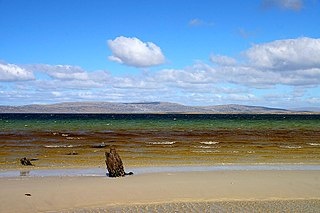
Beauchene Island is the southernmost of the Falkland Islands, lying about 54 kilometres (34 mi) south of Porpoise Point in Lafonia. It was discovered in 1701 by Jacques Gouin de Beauchêne, after whom it was named.

The Falkland Sound is a sea strait in the Falkland Islands. Running southwest-northeast, it separates West and East Falkland.
The Hornby Mountains are a mountain range on West Falkland in the Falkland Islands. Mount Maria is a mountain in this range. The range runs in a group of ridges parallel to Falkland Sound

The Wickham Heights are a rugged chain of mountains on East Falkland in the Falkland Islands. They include the island group's highest peak, Mount Usborne, Mount Wickham and are partly contiguous with No Man's Land. The slopes of Wickham Heights feature numerous stone runs, some of them extending up to 5 km.

Fox Bay is the second largest settlement on West Falkland in the Falkland Islands. It is located on a bay of the same name, and is on the south east coast of the island. It is often divided into Fox Bay East ("FBE") and Fox Bay West ("FBW") making it two settlements: combined, these make the largest settlement on West Falkland, but if separated, Port Howard is the largest. Fox Bay takes its name, like the Warrah River, from the Falkland fox, an animal locally called the warrah and now extinct.
Chartres is one of the main settlements on West Falkland, in the Falkland Islands. It is on the west coast of West Falkland, at the mouth of Chartres River, at the eastern shore of King George Bay. One of the two only proper roads on West Falkland runs between Chartres and Port Howard. It is one of the closest settlements to Mount Adam to the North, the highest point on West Falkland.

Hill Cove is the third largest settlement on West Falkland, in the Falkland Islands, in the north-west. It is on the north coast, on the shore of Byron Sound, and overlooks Port Egmont on Saunders Island, the first British settlement in the islands. Behind the settlement is Mount Adam, which shelters it from southerly winds.
Mount Moody is a hill in the Hornby Mountains on West Falkland, in the Falkland Islands. At 554 metres (1,816 ft), it is the second highest of the Hornby Mountains, after Mount Maria, and the third highest on West Falkland, after Mount Maria and Mount Adam. Like the other Hornby Mountains, Mount Moody consists of a ridge running south-south-west to north-north-west in parallel to the Falkland Sound.
Port Patterson is a settlement on Carcass Island in the western Falkland Islands. It takes its name from the bay it is on, on the south west coast of the island. It was founded in the late 19th century.
Mount Sulivan is a mountain on West Falkland, Falkland Islands, not far from Lake Sulivan. It is to the northwest of Fox Bay.

Mount Kent is a mountain on East Falkland, Falkland Islands, It is north of Mount Challenger and saw action in the Falklands War during the Battle of Mount Harriet – some of the area is still mined.

Hope Harbour is an inlet at the north-west of West Falkland in the Falkland Islands of the South Atlantic Ocean. About 4 km long and 1.3 km wide, it is sheltered by the promontory of Grave Cove Camp in the south, a narrow ridge terminating in Hope Point to the north, Bramble Point Camp to the east, and West Point Island at its entrance to the west. Carcass Island lies 8 km north-east of Hope Point.

Swan Point is the point on the southwest side of the entrance to Queen Charlotte Bay, forming the northeast extremity of Weddell Island in the Falkland Islands.

Weddell Settlement is the only settlement on Weddell Island in the Falkland Islands, situated on the east coast of the island at the head of the sheltered Gull Harbour, part of Queen Charlotte Bay. It is located at 51°53′46″S60°54′27″W, which is 12.15 kilometres (7.55 mi) northeast of Race Point, 15 kilometres (9.3 mi) south by west of Swan Point, 212 kilometres (132 mi) west-southwest of Stanley and 56.6 kilometres (35.2 mi) west of Fox Bay on West Falkland.

Chatham Harbour is the large bay indenting the central part of Weddell Island in the Falkland Islands. It is entered east of Beacon Point and west of Loop Head. The 3 km wide bay extends 5 km in southeast direction, this part of the feature forming an anchorage named Bald Road, and north of Clay Point turning for 10 km in southwest direction. Chatham Harbour is centred at 51°50′16″S60°57′32″W.

Gull Harbour is the 1.3 km wide bay indenting for 2.8 km the east coast of Weddell Island in the Falkland Islands. It is entered north of Gull Point and south of Mark Point, and is centred at 51°53′56″S60°53′20″W. The principal settlement of the island, Weddell Settlement, is situated at the head of the bay. Until the mid-nineteenth century Gull Harbour was known as Great Harbour.

Loop Head is the point on the east side of the entrance to Chatham Harbour in Weddell Island, Falkland Islands. It is located at 51°45′48″S60°53′49″W, which is 2.4 kilometres (1.5 mi) west of Swan Point and 5.5 kilometres (3.4 mi) east-northeast of Beacon Point.

New Year Cove is the 1.7 km wide bay indenting for 2.45 km the southeast coast of Weddell Island in the Falkland Islands. It is entered north of Hadassah Point and south of Circum Point and centred at 51°56′30″S60°54′30″W.

Circum Peak is a mountain rising to 198 m (650 ft) in the southeast part of Weddell Island in the Falkland Islands. It is located at 51°55′45″S60°55′27″W, which is 2.12 km (1.32 mi) southeast of Mount Weddell, and surmounts New Year Cove to the southeast and Gull Harbour to the northeast.











